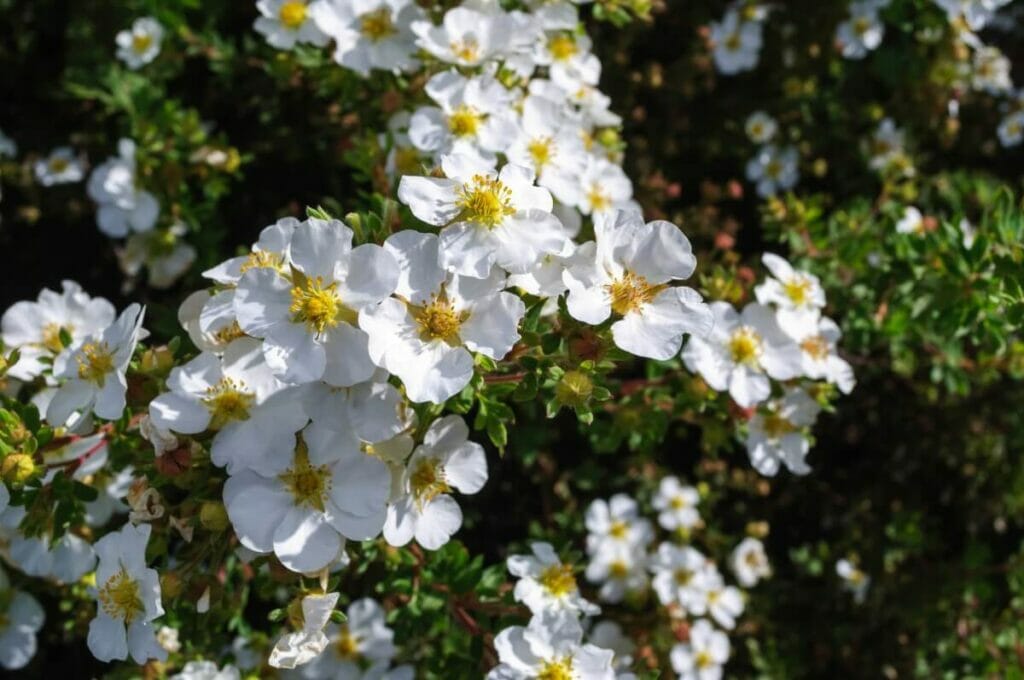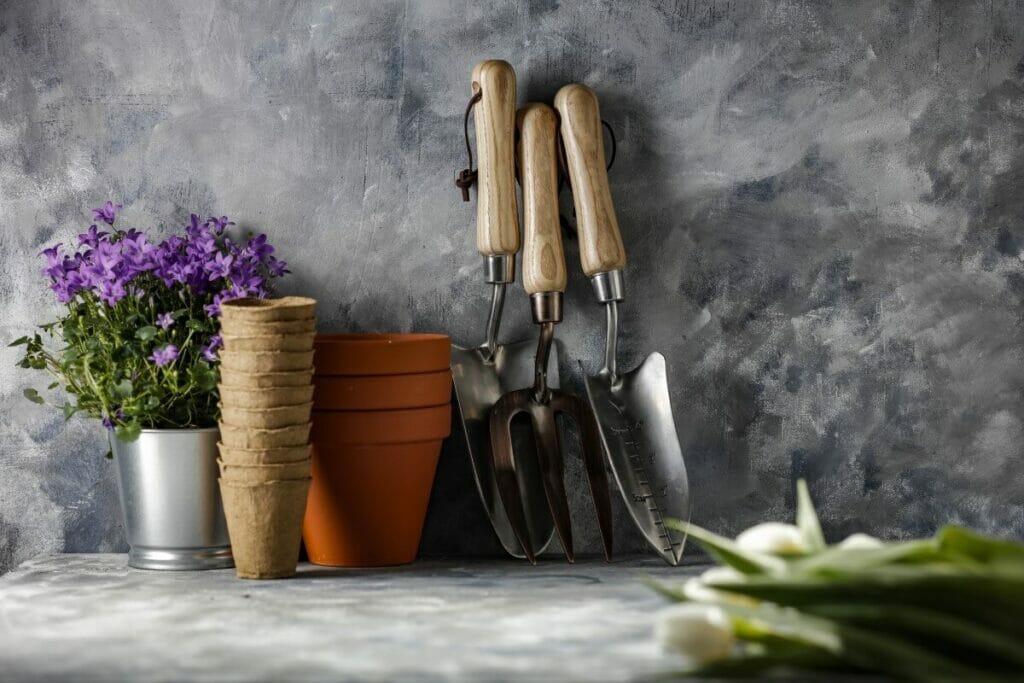Gold Drop Potentilla: Essential Growing and Care Tips
Welcome to our essential guide to growing and caring for Potentilla Gold Drop at home. Nothing creates that cozy, cottage aesthetic like cheerful shrubs framing your home. If you’re interested in achieving this look, a great choice is the Potentilla fruticosa. It’s an easy perennial shrub dotted with small, golden blooms. Read on to learn everything you need to know to grow hardy Potentilla Gold Drop. Its simple care needs and beautiful flowers make this plant a treat for gardeners of any level.

Potentilla Gold Drop Care Essentials:
| Botanical Name: | Potentilla fruticosa ‘Goldfinger,’ Dasiphora fruticosa ’Goldfinger’ |
| Also Known As: | Potentilla Gold Drop, Golden Hardhack, Goldfinger |
| Hardiness Zones: | USDA zones 3 to 7 |
| Flowering Months: | Around May through October, depending on location. |
| Growing Difficulty: | Easy, suitable for beginners |
| Type of Plant: | Deciduous, perennial flowering shrub |
| Light Requirements: | Direct sunlight or partial shade. Does best with at least four hours of full sunlight each day. |
| Temperature and Humidity: | A winter-hardy plant that can endure temperatures as low as -40 degrees Fahrenheit. Prefers low to medium humidity levels. |
| Watering Needs: | Keep soil moist during the first growing season. Water once or twice per week in hot and dry conditions. |
| Soil Preferences: | Well-draining, somewhat fertile soil with a pH between 5 and 7. |
| Feeding: | Minimal fertilizer is required. You may use all-purpose fertilizer or compost in the spring, but you won’t need to do this more than once yearly. |
| Growth Expectations: | It can grow three feet tall with a four-foot spread once it matures. |
| Toxicity: | Non-toxic to humans and pets. |
How to Grow Potentilla Gold Drop:

What Are the Best Locations to Plant?
Simply put, this plant grows well in typical garden conditions. It works well in a partially shaded environment that receives at least four hours of sun daily.
Best Times of Year to Plant
The best time of year to plant Goldfinger Potentilla is early spring. This gives the plant an entire growing season to establish its root system before winter. If you ca unable plant this species in the spring, wait until early fall.
Growing from Seed vs. Young Nursery Plants
Growing Potentilla Gold Drop from seeds or with young nursery plants is easy. However, you should keep in mind that today’s Potentillas are often hybrids.
Because of this, the seeds you harvest may not produce the flowers you’d expect. Starting them as young nursery plants is the best way to guarantee that you end up with Potentilla fruticosa ‘Goldfinger.’
What to Do Before Planting
Before planting Gold Drop shrubs, you’ll need to find a good space to grow them. Choose an area with partial or full sun and plenty of room to grow.
Additionally, check the Essential Tools section below for everything needed to grow this plant.
Best Soil Types
Gold Drop shrubs are tolerant of various conditions. However, they prefer well-draining yet moist soil, especially during their first growing season. Their soil should be moderately fertile with a pH between 5 and 7.
How to Plant
Here are the steps to take when planting Potentilla Gold Drop in the ground.
- Find a space where this plant can grow to its mature spread and height.
- Dig a double-width hole and a similar depth to the plant’s nursery container.
- Remove the Potentilla Gold Drop from its container and massage the roots gently.
- Place the plant in the center of the hole you made, and refill the extra space around the root ball with the soil.
- Add a thin layer of fresh soil to the surface and water thoroughly.
Light Preferences
Remember, this plant prefers an area with partial shade and at least four hours of sunlight daily. Potentilla fruticosa ‘Gold Drop’ doesn’t favor one aspect over another.
Temperature and Humidity Preferences
Goldfinger shrubs are winter-hardy. They survive in temperatures as low as -40 degrees Fahrenheit. This plant may enjoy moist soil during its first year but grows best in low to medium humidity.
How to Care for Potentilla Gold Drop

Watering Needs
Keep soil moist during Potentilla Gold Drop’s first growing season. After that, this plant may receive all the moisture it needs from precipitation.
However, you can water this plant once or twice weekly during hot and dry periods. A good rule of thumb is to water the plant if rainfall is less than one inch per week.
Fertilization
Potentillas don’t need to be fertilized regularly. If you’d like to apply fertilizer, you can use an all-purpose solution every year or two.
Pruning
The best time to prune Potentilla Gold Drop is in the late winter. The foliage and blooms will have died back a bit, so you can get a good idea of where and how to trim the plant’s branches.
Use clean, sharp pruners to trim branches about eight inches above the ground. This allows the plant to push out healthy growth during the growing season.
Propagation
You can propagate this species by taking cuttings during the early summer months. Take a four-inch cutting of new growth just below a node. It is best to cut a branch that doesn’t have any blooms.
After cutting, pinch away any foliage from the lower half of the branch. Dip the cut end into rooting powder and place it into some fresh compost.
Keep cuttings in bright, filtered sunlight and moisten soil until roots form. This process can take up to one month.
Overwintering
As Potentilla Gold Drop is cold-hardy, it won’t need much winter maintenance. Just prune in late winter to encourage growth during the next blooming season.
Repotting
You can also grow Potentilla fruticosa ‘Goldfinger’ as bonsai plants in containers. Just go up one pot size if the plant becomes root-bound. Here are the steps to take for repotting Potentilla Gold Drop.
- Find a container one size larger than the plant’s current pot. This planter must have a drainage hole.
- Add some pebbles to the container’s base, then add a neutral, well-draining soil layer.
- Ensure no air pockets are in the soil before adding the root ball.
- Place the root ball in the container so its surface sits a few inches below the pot’s lip.
- Fill the space around and above the root ball with soil, ensuring no air pockets in the container.
Deadheading
It isn’t necessary to deadhead Gold Drop Potentilla shrubs. If you prune them in the winter, they’ll bloom healthily during their growing season.
Common Problems and How to Treat Them

Signs of Watering Issues
Potentillas are tolerant of drought, but their roots may rot if they grow in a soggy environment. On the other hand, if the plant is too dry, its leaves may begin to curl or droop.
Avoid watering issues by simply allowing nature to do the work for you. Water this plant only if rainfall dips below one inch per week.
Signs of Improper Light Conditions
If Potentilla receives too much light, its blooms may fade faster. Too little light may cause the plant to look spindly. Prevent these issues by planting Potentilla fruticosa ‘Goldfinger’ in its preferred growing conditions.
Common Pests and Diseases
Generally, this species doesn’t have many issues with common garden pests or diseases. However, there are still some pests and diseases worth mentioning. Here are the most common problems you may run into and ways to treat them.
- Spider mites: Spray the plant with soapy water or an insecticide solution until the infestation subsides.
- Weevils: Remove any visible weevils by hand and use an insecticide until the issue subsides. You can also try predatory insects like beetles or parasitic nematodes.
- Root rot: Trim away the affected area and soil and replant shrubs in fresh soil.
Essential Tools to Have Around

Here is a complete list of the tools you’ll want for Potentilla fruticosa ‘Goldfinger.’
- A neutral, well-draining soil
- Sharp pruners
- A shovel
- Rooting powder for propagation
- All-purpose fertilizer if required
- Container with a drainage hole, if needed
- Pebbles for added drainage
Wrapping Up
With the right tools and care guidance, you will grow gorgeous Gold Drop shrubs in your garden this spring. A little effort goes a long way with this plant; once you’re done, you can enjoy blooms for years.
Brandy Wells is an American copywriter and content writer living in Spain. From hiking in her hometown near the Smoky Mountains to digging in the dirt in rural Oregon, she has always put a love of nature at the heart of her endeavors. These days, you’ll catch her writing content, and of course, taking breaks to tend to her growing houseplant collection.

